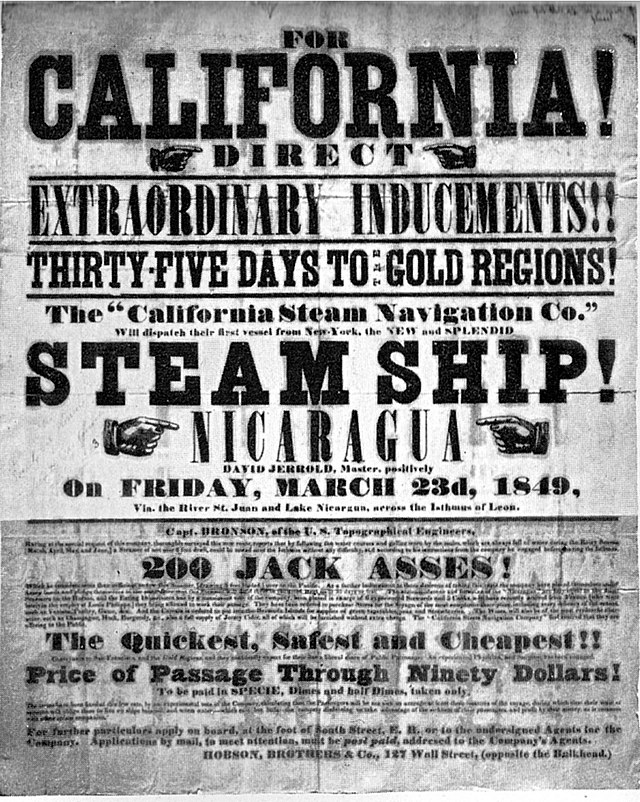California Gold Rush
gold rush from C.E.1848 until 1855 in California From Wikipedia, the free encyclopedia
Remove ads
During the California Gold Rush, around 300,000[1] people traveled to California after gold was found at Sutter's Sawmill. The Gold Rush lasted from 1848–1855, peaking in 1852.[1]
This article does not have any sources. (June 2020) |
While around $2 billion in gold was found during the Gold Rush, very few gold miners got rich.[1]
The Gold Rush had major effects on California's history, economy, and population. People came from all over the world to look for gold. The population boomed, and San Francisco became one of America's major cities.
Remove ads
Beginnings and growth

Before gold was discovered in 1848, California's population was around 160,000; most of these people were Native Americans.[1] California became a state in 1850, and by about 1855, more than 300,000 people had arrived in California.[1]
In early 1848, a carpenter named James Wilson Marshall found small flakes of gold in a river while building a water-powered sawmill for John Sutter.[2] He immediately went to tell Sutter, and they tried to keep the gold a secret.[3] But word soon got out, and thousands of people started rushing west to look for gold. People who arrived in 1849 were nicknamed "forty-niners."
Over the next few years, hundreds of thousands of people traveled to California to seek their fortunes:[1]
- By August 1848, just a few months after gold was found at Sutter's Sawmill, there were 4,000 gold miners in California.
- By August 1849, there were around 80,000.
- By 1853, there were around 250,000.
Remove ads
People and jobs

Some of the gold miners (also called "prospectors") found large amounts of gold and became wealthy, but most did not.
Not everyone who went to California during the Gold Rush looked for gold. Some opened businesses to provide services to gold miners (like clothing stores, barber shops, bakeries, and launderers).[4] A few got rich and powerful this way, like Levi Strauss, who invented jeans made of strong denim.[5]
Usually merchants, farmers, and other people who sold supplies earned more than gold miners. Sometimes a woman could earn more than her gold-mining husband.
Remove ads
Effects
The Gold Rush had a major impact on California's history, economy, and population. California was not a state when the Gold Rush began, but it became a state in 1850.[1]

Before gold was discovered in 1848, the California territory's population was around 160,000; most of these people were Native Americans. By about 1855, more than 300,000 people had arrived. However, from 1851–1853, around one in every five people who arrived in California died within the next six months.[6]
California's population grew very rapidly. Between 1847 and 1860, California's population tripled.[7] Meanwhile, San Francisco became a major American city.[6] When the Gold Rush started, around 1,000 people lived there. Within two years, its population increased by 2,400%, and it had 25,000 full-time residents.[8]
This was also a time when many people immigrated to the United States. For example, of 67,000 people who came to California in 1852, 4 in every 10 (20,000 people) came from China.[7] They mined, built railroads, and worked on farms.[7]
Native Americans, dependent on traditional hunting, gathering and agriculture, became the victims of starvation and disease, as gravel, silt and toxic chemicals from prospecting operations killed fish and destroyed habitats.[9][10] The surge in the mining population also resulted in the disappearance of game and food gathering locales as gold camps and other settlements were built amidst them. [11]
Ending
As the Gold Rush went on, gold became harder and harder to find. Many of the forty-niners returned to their home countries, or gave up mining gold and found other work in California.
The California Gold Rush ended in 1855.
Related pages
References
Wikiwand - on
Seamless Wikipedia browsing. On steroids.
Remove ads